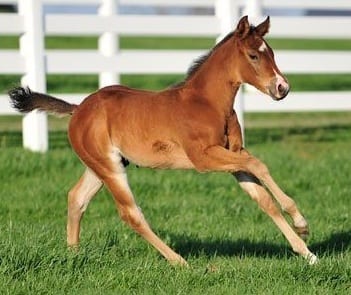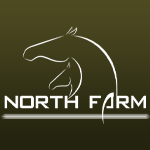Of course, it depends on who you talk to about whether the breeding industry is starting to recover, but there is no doubt that the struggling economy has greatly effected all aspects of the horse industry.
GoHorseShow.com talked to five major breeders in the horse industry and asked them their thoughts about the current state of the industry.
Amy Gumz of Gumz Farms who stands several top Paint and Quarter Horse stallions such as Certain Potential, Huntin for Chocolate, A Scenic Impulse, No Doubt Im Lazy, Iron Age, Only in the Moonlite, These Irons Are Hot, and A Major Leaguer, on her farm located in Morganfield, Kentucky.
We also spoke to general manager of Pine View Farm, Debbi Trubee, who along with Roger Landis, runs the breeding operation and stands two of the top stallions in the nation, Invitation Only and Lazy Loper. Another top breeder, Joan Schroeder, who stands Blazing Hot, Born to Be Blazing and Lena Spark discussed her breeding business and what she thinks about the future of the industry at Schroeder Ranch located in Gainesville, Texas.
We reached out to Rebecca Halvorson of Halvorson Ranch located in Guthrie, Oklahoma who stands two gorgeous Palomino halter stallions, BRT Limited Edition and Mr Fancy Fella where she seemed to take a more optimistic view on the current condition of the halter breeding industry.
GoHorseShow.com finally discussed the issue with the opinionated, Robin DeGraff of DeGraff Quarter Horses of Midway, Kentucky who stands several top stallions like Indian Artifacts and HBF Iron Man.
Let’s see what they had to say!
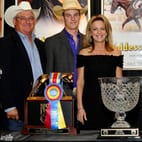 Joan Schroeder of Schroeder Ranch—The breeding industry has started to make a comeback. It is getting better. There were way too many stallions, and when there is an economic recession, the middle and lower end quality stallions struggle. It was a necessity and actually a painful blessing in disguise. The weaker studs get weeded out, and the whole market readjusts itself to be profitable again.
Joan Schroeder of Schroeder Ranch—The breeding industry has started to make a comeback. It is getting better. There were way too many stallions, and when there is an economic recession, the middle and lower end quality stallions struggle. It was a necessity and actually a painful blessing in disguise. The weaker studs get weeded out, and the whole market readjusts itself to be profitable again.
 Rebecca Halvorson of Halvorson Ranch—The past couple of years have been very tough on the halter breeding industry in general, but I see some light at the end of the tunnel. We have been at the lowest point in the breeding industry the last few years, but I am an optimist. I believe everything runs in cycles and at some point, the halter breeding industry will return to its past glory. We have seen some recent positive changes in the industry with the formation on the World Conformation Horse Association and its growth even during these difficult times. As far as the Palominos, we are lucky to be standing two of the top Palomino halter stallions in the nation, BRT Limited Edition, and Mr Fancy Fella–so it doesn’t hurt our business at all when we are able to stand such high quality stallions.
Rebecca Halvorson of Halvorson Ranch—The past couple of years have been very tough on the halter breeding industry in general, but I see some light at the end of the tunnel. We have been at the lowest point in the breeding industry the last few years, but I am an optimist. I believe everything runs in cycles and at some point, the halter breeding industry will return to its past glory. We have seen some recent positive changes in the industry with the formation on the World Conformation Horse Association and its growth even during these difficult times. As far as the Palominos, we are lucky to be standing two of the top Palomino halter stallions in the nation, BRT Limited Edition, and Mr Fancy Fella–so it doesn’t hurt our business at all when we are able to stand such high quality stallions.
 Debbi Trubee, of Pine View Farm— We have been blessed with Lazy Loper’s success as a sire, so, our numbers have steadily increased over the last three years. The one thing that we have done to maintain our numbers is to keep Lazy’s breeding fee affordable to everyone. In years gone by, a stallion owner could have raised a young stud’s fee considerably once they were established as a sire, but, in today’s market, people just don’t have the disposable income they used to have so they want to get the most bang for their buck.
Debbi Trubee, of Pine View Farm— We have been blessed with Lazy Loper’s success as a sire, so, our numbers have steadily increased over the last three years. The one thing that we have done to maintain our numbers is to keep Lazy’s breeding fee affordable to everyone. In years gone by, a stallion owner could have raised a young stud’s fee considerably once they were established as a sire, but, in today’s market, people just don’t have the disposable income they used to have so they want to get the most bang for their buck.
The yearling market also became flooded and the numbers far outweighed the buyers, and I think that has been a contributing factor in the downturn in the breeding business. The numbers now are considerably less as far as people breeding and that will make the dollars go up on what is available in the very near future. It is a simple fact of supply and demand. There will always be a market for a great prospect, and I think mare owners have to be more particular about what they breed and to whom.
With regard to trying to establish a young stallion in today’s market, it’s really tough to make that happen. People are steering to the tried and true and are not as willing to take a chance on a young horse like they used to.
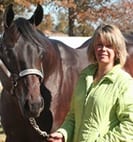 Amy Gumz of Gumz Farms—Without question the breeding business has been hit hard by our economy and soft horse sales. I think our business (personally) has been down by 40-50%. Fortunately, we have some popular sires that withstand the downward trend in our economy and horse market. However, the junior stallions and middle to lower price range stallions have been hit the hardest. I see the Paint and Appaloosa market hit even harder than the Quarter Horse market. My understanding is that AQHA is seeing a huge decrease in foal registrations this year which substantiates this statement.
Amy Gumz of Gumz Farms—Without question the breeding business has been hit hard by our economy and soft horse sales. I think our business (personally) has been down by 40-50%. Fortunately, we have some popular sires that withstand the downward trend in our economy and horse market. However, the junior stallions and middle to lower price range stallions have been hit the hardest. I see the Paint and Appaloosa market hit even harder than the Quarter Horse market. My understanding is that AQHA is seeing a huge decrease in foal registrations this year which substantiates this statement.
I feel that we are starting to see a turn around as supply and increased demand will help to self regulate our business. Lower number of quality horses will generate an increase in demand and pricing which should yield an increase in breeding. I am hopeful that the breeders that have toughed out the past couple of years will be rewarded with increase foal prices and marketability. I am already starting to see this.
I see breeders wanting to stay with the proven stallions to minimize the risk when making their sire decisions. I see the them having to offer more concessions to attract a strong mare book. Less people are willing to gamble as many are breeding fewer mares. Many stallion owners are offering generous incentives to breed to their stallions with good success. I think Rodrock’s Ride to the Riches program is an excellent example of this.
The Kentucky Incentive Fund Program did stimulate the breeding industry when it went began in 2008. It is a great program but not the complete fix that many assumed it was. It is by far the best incentive program in our industry. I think the Kentucky program has the potential to be a long term economic development program, and I personally would not buy a show horse that was not in the Kentucky Breeders Incentive Program unless I just couldn’t find one.
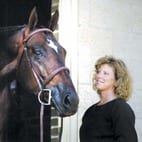 Robin DeGraff of Liberty Farms–Growth in the horse industry related to the economy is threatened by individuals having to take a very close look at how they are choosing to spend their discretionary dollars. People are having to make choices against the expense of horses due to rising costs but also perceived value of their expenses. I believe that deters new people from entering the horse business, whether from a social aspect, i.e. a show horse for their daughter/son, or from a business standpoint. They are threatened by the perception that horses are owned by the wealthy.
Robin DeGraff of Liberty Farms–Growth in the horse industry related to the economy is threatened by individuals having to take a very close look at how they are choosing to spend their discretionary dollars. People are having to make choices against the expense of horses due to rising costs but also perceived value of their expenses. I believe that deters new people from entering the horse business, whether from a social aspect, i.e. a show horse for their daughter/son, or from a business standpoint. They are threatened by the perception that horses are owned by the wealthy.
The cost of entry into other sports like soccer is much less and requires a t-shirt, short and good shoes. Horses require purchase, equipment, on-going board, training, and access to hauling. We do a lot of advertising and promoting within our own breeds/associations. However, to reach new customers, whether in the cities or non-rural areas, we have to try to compete with hobbies and activities that are a lot less expensive–movies, golf, bowling, and computers are some examples. With liability issues, it is also hard for many horse operations to even open up riding lessons to the public. We are also losing land daily to malls, housing complexes and other developments.
It is hard to promote stallions in this day and age. With the advent of shipped semen, people by and large do not travel to farms to actually view stallions anymore. We rely on pictures and video to make choices regarding movement and conformation. While I strongly believe in a good marketing and advertising program, I dislike it when important items get missed in our virtual society.
What do you think about the current state of the breeding industry? Do you agree with these breeders’ opinions? Please take our reader poll.


